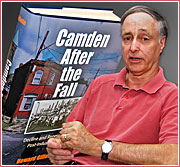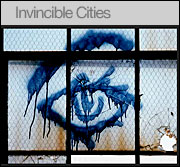FINDING CAMDEN'S FUTURE IN ITS HISTORY
Book and Web Site Document Once-Thriving City

By Hoag Levins ...| ...May 10, 2006

CAMDEN, N.J. -- In describing his reason for titling his new book "Camden After The Fall," Howard Gillette likened this city of decay and political controversy to "a prize fighter who has been on the ropes a lot, with one knee down; bloody and battered, but still trying to come back."

|
| Photo: Hoag Levins |
Much of Howard Gillette's book tells the story of Italian, Polish, Jewish, African American and Hispanic neighborhoods that once formed the self-supporting matrix of "Old Camden" when the city was a vibrantly functional metropolis.
|
And, indeed, in poignant human detail, his book chronicles the sad post-World War II struggles of the once-mighty industrial juggernaut that has become one of the nation's most problematic urban areas; a place of stark contrasts where a sea of slums and grinding poverty laps the edges of a glittering waterfront island of entertainment attractions.
In both a presentation at the Camden County Historical Society and a private interview at his Haddonfield home, Mr. Gillette provided insights into the seven-year project that produced a book that is both a major work of historic scholarship as well as a weapon in the current debate over the direction of the city's redevelopment efforts.
MARCH organization
A professor of history at Rutgers University in Camden, he is also a former Trustee of the Camden County Historical Society who relinquished that post when he was named director of the Mid-Atlantic Regional Center for the Humanities (MARCH) at Rutgers. The organization's mission is to support a better public understanding of the history and heritage of the Mid-Atlantic region. Its Camden-related activities have been supported by the Ford Foundation since 2003.
In terms of history, the first third of Professor Gillette's book is the most interesting. Based on information gathered from 300 interviews with current or former residents of Camden, it tells a richly detailed story of the Italian, Polish, Jewish, African American and Hispanic neighborhoods that once formed the self-supporting matrix of "Old Camden" when the city was a vibrantly functional metropolis.

|
Excerpts from Gillette's talk at the Camden County Historical society.

|
"Old Camden was a city that worked," he said. "It was, sociologically, the epitome of the ethnic, melting pot city. Groups congregated around their churchs and synagogues and had the community resources to help each other out in times of difficulty. At its height, Camden had 55,000 industrial jobs and a lot of social capital. This was a city that held together very well during World War I, the Depression, and periods of tremendous change."
White exodus
And then the bottom fell out. The white middle class began its exodus to the surburbs -- a process accelerated by the city's 1971 riots as well as the lure of the new economic engine created by the then-unique Cherry Hill Mall which opened in 1961.
Over the seven years of his project, Gillette used the Historical Society's facilities in Parkside to conduct many of his interviews. He has donated the project's notes and other files to the Society, which is incorporating the materials into its historical archives.
The professor is quick to point out that seven years ago, he was a newcomer to Camden and was often surprised by what he encountered during his research. For one thing, the city's archive of records -- or lack thereof -- was a major impediment to a historian trying to reconstruct the past actions and motivations of government and political leaders.

|
Providing an unusually rich visual dimension to Gillette's book project is its affiliate Web site, 'Invincible Cities,' featuring more than 400 photos of Camden by Camila Jose Vegara, a New York-based photographer and MacArthur Fellow who has been photographing the city's streetscapes since 1979.
|
"I pretty much started at the Historical Society because there are so few good records anywhere else, and the Society had the best public memory of what exists in the city of Camden," Professor Gillette said. "Some of the (crucial) old newlspapers, including some of the suburban journals, are not accessible elsewhere. They were very important. Photographs were very important in trying to get a sense of what the city used to look like, including even some of the old post cards that are in the Society's collections.
Camden's racial history
Another unexpected finding had to do with the city's racial history. "I was shocked to learn the degree to which African Americans were tightly segregated in Camden. Not in all aspects of life but in many -- the primary schools, movie theaters and restaurants, for instance. One of the most powerful factors weighing against the black community was the lack of housing. For many years, African Americans had been confined to a limited number of housing units both in the private market and in public housing. Much of the public housing was reserved for whites only. And, as a consequence, as the the black community grew in the post-WWII period, there was a lot of pressure for housing that led to public protests in the 1960s lead by the NAACP."
Beyond the history of the city's ethnic enclaves, "Camden After the Fall" goes on to document the collapse of the city as the region's social and commercial center, and then focuses on the series of failed urban redevelopment attempts that preceded the current one. The latest effort has given rise to the waterfront tourist zone as well as a controversial plan for the massive development of new residential communities along the city's northern shore, opposite Petty's Island.
Past redevelopment failures
The professor, who makes a point of not directly criticising the current redevelopment efforts in his interviews, has crafted a book whose facts tell a different story. It is this: Over the past several decades, a succession of Camden leaders have engaged in a series of efforts to tear down slum neighborhoods, find new sources of investment, lure back merchants, finance housing and secure new engines of employment within the city. But these efforts have addressed the issues in a manner that assumes a resurgent Camden will be repopulated by middle class whites at the expense of its predominantly poor non-white residents. Despite decades of such efforts, Camden today remains a place where opportunities for the common man are as unavailable as its streetscapes are bleak.
The book, in its facts, makes a quiet but powerful argument that the current redevelopment projects are repeating the same mistake of trying to rehabilitate a city without rehabilitating its residents; and of failing to come up with a vision or method that truly enables that city and its residents to stitch themselves back into the social and fiscal fabric of the wealthy suburbs that surround them.
Unusual Web site affiliation
One of the most unusual aspects of Gillette's book is its symbiotic relationship with the "Invincible Cities" (invinciblecities.camden.rutgers.edu) Web site that complements it. Also funded by the Ford Foundation, the online photo documentary project is a collaboration beween Gillette's MARCH and Camila Jose Vegara, a New York-based photographer and MacArthur Fellow who has been photographing the streetscapes of Camden's changing neighborhoods since 1979.
The Web site is driven by a database of more than 400 aerial and sidewalk-level images of Camden's building stock and commercial districts indexed to visual screen maps. A visitor to the site can "fly" above the city streets and click down to see specific sections of the urban area as well examine some of those areas have changed since 1979.
Mr. Vegara continues his work because the site was conceived as an organic documentary that continues to evolve as Camden changes.
"I see the Web site primarily as an educational tool," said Gillette. "Ninety percent of the population of the region looks at Camden as something 'out there' -- they have no access to the place itself beyond the kind of single image they may see in a a newspaper story. But seeing multiple images and statistics over time may enable them to envision how a place changes."
"With a book, you always have to stop telling the story in order to publish the work," he said. "But the neat thing about this interactive project is that it can be an ongoing and open-ended conversation with the public. The story continues for anyone to watch. The hope is that this Web site will ultimately become a documentary record of the transition between the Old Camden and whatever becomes the New Camden."
All Rights Reserved © 2006, HistoricCamdenCounty.com
HoagL@earthlink.net
.
About this Web site
..
|





